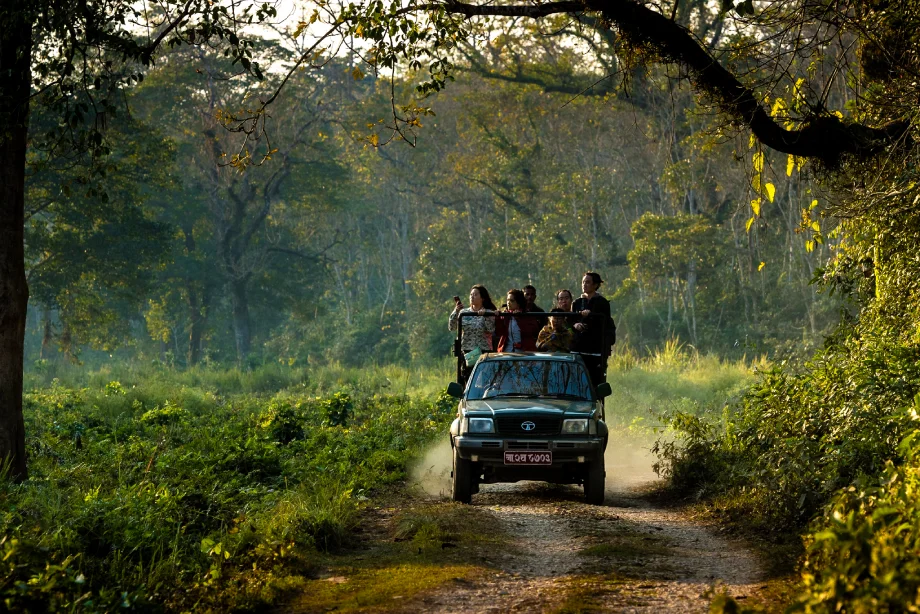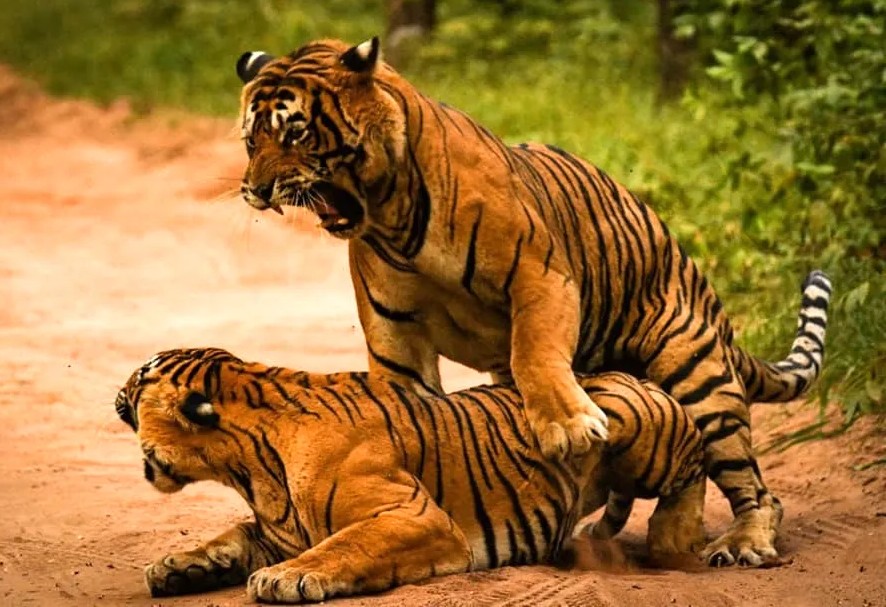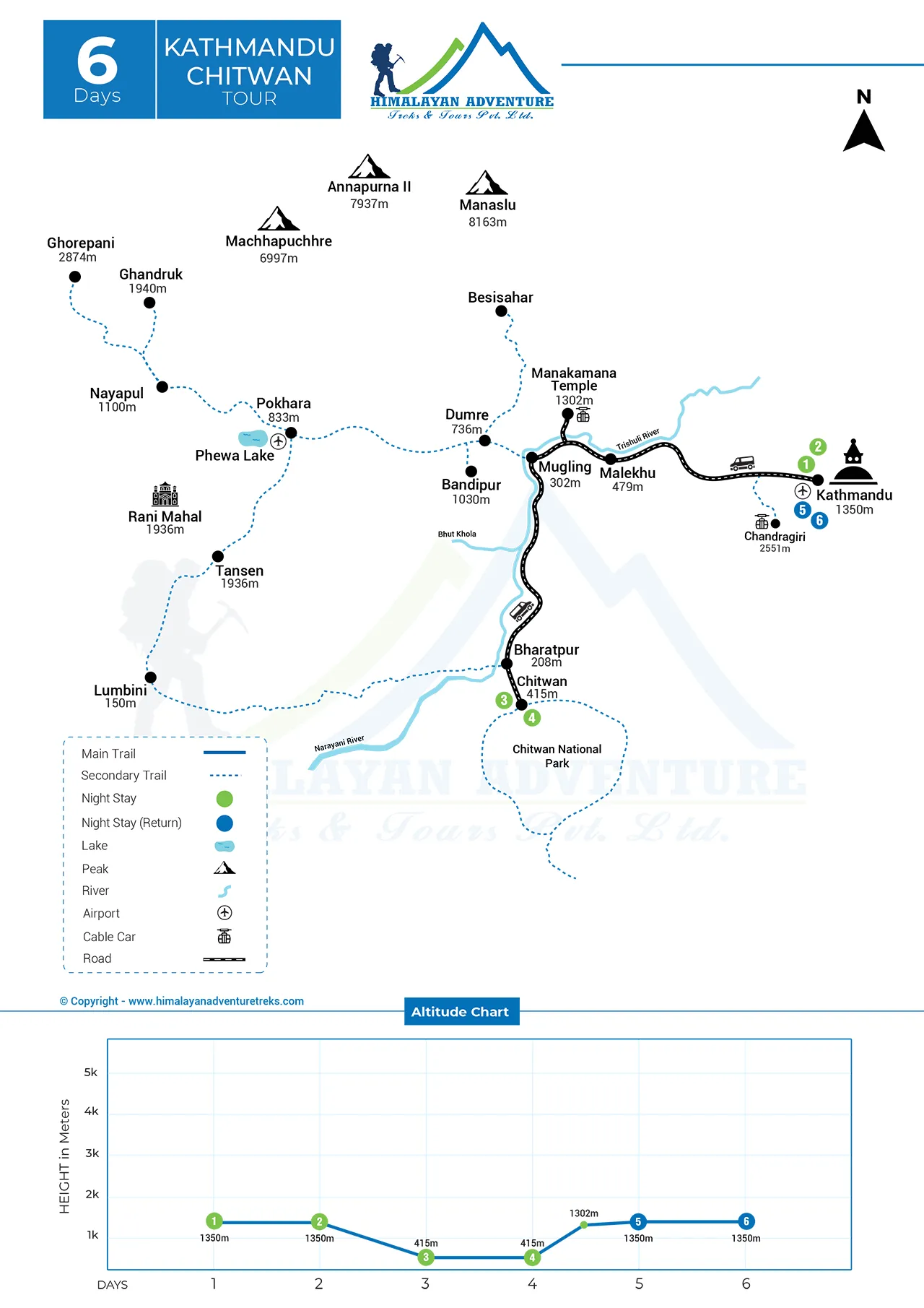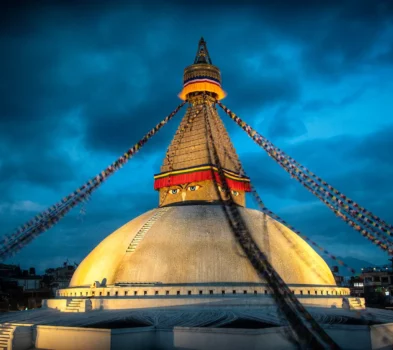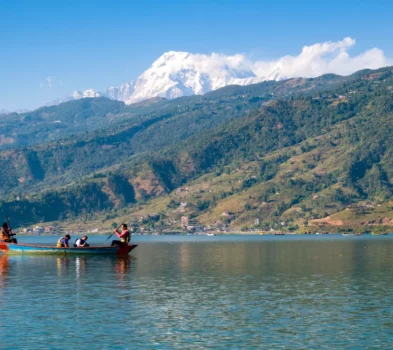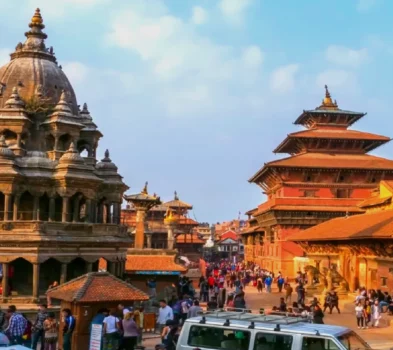Duration
6 DaysKathmandu Chitwan Tour
Trip Grade
EasyGroup Size
1-16 PeopleMax Altitude
1,400m. / 4,593ft.Best Season
Feb- May/ Sept-NovActivity
Multiple ActivitiesMeals
Breakfast, Lunch & DinnerAccommodation
Hotels & ResortTransportation
Private VehicleTrip Customization
On request (click here)Highlights of Kathmandu Chitwan Tour
- Explore the UNESCO World Heritage Sites of Kathmandu.
- Spectacular sunrise views over the Himalayas from Manakamana.
- The scenic 10-minute cable car ride to Manakamana temple, the sacred temple of the Hindu Goddess Bhagwati.
- Thrilling jungle safari tour in Chitwan National Park.
Trip Introduction
Enjoy a surreal display of the Himalayas and the natural beauty of Nepal on the Kathmandu Chitwan Tour. As the name suggests, the tour takes you to these famous locations with incredible beauty. Kathmandu is famous for the array of world heritage sites like Pashupatinath, Swayambhunath (Monkey Temple), Boudhanath, and Kathmandu Durbar Square.
Likewise, Manakamana Temple offers a panorama of the mountain ranges in a warm local company. Finally, Chitwan is home to a wide variety of flora and fauna, along with the ethnic Tharu culture. All in all, the tour is best for travelers with families and those who desire to enjoy Nepal without physical strain.
The tour begins in Kathmandu, where you spend an entire day enjoying the world heritage sites in the valley. It is home to seven of the ten world heritage sites in the valley. Here, you can visit the heritage sites and relish the cultural history of the country. Also, the display of art and crafts is equally grand. While exploring the valley, you can also take a look at the religious artifacts and murals.
After Manakamana Temple, Chitwan is the next stop on the tour. It houses the Chitwan National Park, one of the ten world heritage sites in Nepal. Also, the national park has the tallest grasslands in the world, along with rare wildlife like the Greater one-horned rhinos and the Royal Bengal Tiger. Moreover, the Tharu culture and lifestyle are also the highlights of the Chitwan tour. Finally, the jungle safari and visit to the local breeding center cap off the trip to Chitwan.
The trip is straightforward, and anyone can complete it. Also, you can opt for this tour all year.
At Himalayan Adventure Treks, we have the very best team with skilled guides, porters, and other staff. As such, we offer standard travel services to our clients. Also, we have various trips and offers across the country.
Outline Itinerary of Kathmandu Chitwan Tour
Day 01: Arrival at Kathmandu Airport.
Day 02: Kathmandu Valley City Tour.
Day 03: Drive from Kathmandu to Chitwan.
Day 04: Jungle Safari in Chitwan National Park.
Day 05: Drive from Chitwan to Kathmandu via Manakamana Temple.
Day 06: Departure to Kathmandu Airport.
Our guests sharing their experiences (Photo/Video Gallery)
Detail itinerary of Kathmandu Chitwan Tour
Day 01: Arrival at Kathmandu Airport.
Your arrival in Kathmandu will be marked by landing at the Tribhuvan International Airport (TIA). A company representative of Himalayan Adventure Treks & Tours will receive you and transfer you to your hotel. Evening you can meet the participants and the tour members. Overnight stay at a hotel in Kathmandu.
Activity: Airport Pickup, 30 min
Max. Altitude: 1,400m/4,593ft. Kathmandu
Accommodation: Hotel
Day 02: Kathmandu Valley City Tour.
After breakfast, we start for the Kathmandu city tour which includes four of the UNESCO heritage site in the valley.
Pashupatinath: The temple is one of the most sacred pilgrims sites for Hindus all over the world. It is the temple of Lord Shiva, the temple where the dead bodies are criminated on the bank of the Bagmati River.
Boudhanath Stupa: which is one of the biggest stupas in Asia and holiest Budisht Pilgrims and famous tourist destination in Valley. It is also famous for over 50 Tibetan gompas or monasteries.
Kathmandu Durbar Square: It holds the places of the ancient king who ruled over the then Kathmandu Kingdom.
Swayambhunath (Monkey Temple): It is located in the heart of the valley. it is another famous tourist destination and holiest Buddhist pilgrims. it is also known as Monkey temple among tourists.
Activity: Sightseeing, 5-6 hours
Max. Altitude: 1,400m/4,593ft. Kathmandu
Meal: Breakfast
Accommodation: Hotel
Day 03: Drive from Kathmandu to Chitwan.
The drive from Kathmandu to Chitwan covers approximately 160 kilometers (99 miles) and takes around 5 to 6 hours, depending on road conditions and traffic. The journey begins on the Prithvi Highway, winding through scenic hills, terraced farms, and alongside the Trishuli River, which is popular for white-water rafting. As you descend from the Kathmandu Valley, the air gets warmer, and the landscape transitions into the flatlands of the Terai region. Along the way, you pass through small towns like Mugling, where the highway splits toward Pokhara and Chitwan. From Mugling, you take the Narayanghat road, which is relatively smoother and leads toward Sauraha, the main gateway to Chitwan National Park. Upon arrival, you can check into a jungle lodge or resort and prepare for wildlife activities like a Tharu cultural dance show, jungle safari, or canoe ride the next day.
Activity: Drive & Jungle Activities, 7-8 hours
Max. Altitude: 450m/1,476ft. Chitwan National Park
Meal: Breakfast, Lunch & Dinner
Accommodation: Resort
Day 04: Jungle Safari in Chitwan National Park.
Morning breakfast, we will go for a Canoe ride for about 1 hour where you can see lots of crocodile-like Gharial and Mugger then we will walk inside the jungle to explore the wild animals, birds. Then we, visit the Elephant breeding center.
Afternoon we will have lunch then we go for a Jeep safari inside the National park for 4 hours or an elephant back safari. Where we see lots of animals including the Royal Bengal Tiger (if we are lucky).
Activity: Jungle Safari, 7-8 hours
Max. Altitude: 450m/1,476ft. Chitwan National Park
Meal: Breakfast, Lunch & Dinner
Accommodation: Resort
Day 05: Drive from Chitwan to Kathmandu via Manakamana Temple.
The drive from Chitwan to Kathmandu via Manakamana Temple covers approximately 175 kilometers (109 miles) and takes around 6 to 7 hours, depending on traffic and road conditions. You start by driving from Sauraha to Mugling, where you join the Prithvi Highway, passing through lush forests and riverside villages. At Kurintar, about 2.5 hours from Chitwan, you can take a 10-minute cable car ride up to Manakamana Temple, a sacred Hindu pilgrimage site dedicated to Goddess Bhagwati. The temple offers stunning views of the Himalayas, Trishuli River, and green valleys, making it a perfect stop for sightseeing and spiritual blessings. After the visit, you continue the drive along the Trishuli River, enjoying the scenic hills and terraced farmlands. As you ascend toward Kathmandu Valley, the air becomes cooler, and you gradually return to the bustling city.
In the evening we will have a farewell dinner at an authentic Nepalese restaurant with a cultural performance.
Activity: Drive, 6-7 hours
Max. Altitude: 1,400m/4,593ft. Kathmandu
Meal: Breakfast & Dinner
Accommodation: Hotel
Day 06: Departure to Kathmandu Airport.
A representative from Himalayan Adventure Treks and Tours will take you to the airport, approximately 3 hours before your scheduled flight. On your way home you’ll have plenty of time to plan your next adventure in the wonderful country of Nepal.
Activity: Airport drop, 30 min
Max. Altitude: 1,400m/4,593ft. Kathmandu Airport
Meal: Breakfast
Note:
If you have your own private group and want to make your trip private, we can run the custom trip all the day as per your requirements and group size.
Includes and Excludes
What are included with package?
- Three Nights 3-Star Hotel in Kathmandu with Breakfast: Comfortable accommodation in Kathmandu including daily breakfast.
- Two Nights 3-Star Hotel in Chitwan with Full Board Meals: Includes breakfast, lunch, and dinner during your stay in Chitwan.
- Activities in Chitwan National Park: Jungle safari, canoeing, bird watching, elephant breeding center visit, etc., as part of the Chitwan package.
- Chitwan National Park Fees: Entry permits and national park fees are fully covered.
- All Overland Transfers Using Private Vehicle: Private ground transportation between Kathmandu and Chitwan, and for local sightseeing.
- Kathmandu & Chitwan Sightseeing Tour with Local Guide: Guided city tours in both Kathmandu and Chitwan with an experienced, English-speaking local guide.
- Farewell Dinner: A cultural farewell dinner at an authentic Nepali restaurant featuring traditional performances on the final night of the tour.
What are not included with package?
- Lunch and Dinner (Except in Chitwan National Park): Meals in Kathmandu and during travel days are not included, except for the full board meals provided in Chitwan.
- Beverages and Alcoholic Drinks: Any soft drinks, bottled water, or alcoholic beverages are at your own expense.
- Cable Car Ticket: Fees for rides such as the Manakamana cable car are not covered in the package.
- All Entrance Fees in Kathmandu: Entry tickets for heritage sites and monuments in Kathmandu are excluded.
- Extension of Any Other Tours/Accommodation: Additional activities or hotel stays beyond the itinerary are not included.
- All Kinds of Personal Expenses: Personal items like laundry, tips, souvenirs, and phone/internet charges are not part of the package.
Pick Your Suitable Date
Book a Private Trip
Private & Group Discount Price
-
1 -
1 person
US$ 800
-
2 -
2 people
US$ 600
-
3 -
5 people
US$ 550
-
6 -
10 people
US$ 500
-
11 + people
9999
US$ 450
Total Cost:
US$ 800
Route Map & Altitude Chart
Kathmandu
Start/End point
Kathmandu
Trip Information
Entrance fees of Heritage Sites of Nepal:
Nepal is famous for world heritage sites, Tourist attractions places, and monuments areas. Tourism is the second income source of the country. Entrance fees, National park fees, climbing royalties are the backbone of the Nepalese economy. Foreigner tourists visiting heritage sites, attraction places, and monuments of the country and have to pay a certain entrance fee to get inside the area. The people of South Asian countries (SAARC) have to pay fewer entrance fees in comparison to tourists from other countries. Many tourists want to see the typical Nepalese art and cultural places, happily paying the entrance fee because it is worth paying to visit.
The 7 heritage sites of Kathmandu valley are amazing. Boudhanath, Pashupatinath, Swayambhunath, Kathmandu Durbar Square, Patan Durbar Square, Bhaktapur Durbar Square, and Changunarayan have their own history. They are not only rich in art and architecture but also fountain spiritual places of Hinduism and Buddhism. Most of the constructions made have a tantric background and old history. Not only the Kathmandu valley but other parts of the country are also rich in nature and history. Lumbini (Birth Place of Gautam Buddha) Chitwan National park, Pokhara, Nagarkot, Trekking trails, Peak climbing, Expedition are the main tourist destination in Nepal and main income sources of the country. It is the government that keeps the price of priceless monuments and makes some money from tourists who visit them.
Please find the attached PDF file for the Entrance fees of World heritage and other attraction places in Nepal.
Entrance Fees of UNESCO World Heritage Sites in Nepal
About Country
Popularly recognized worldwide for its majestic sky-dominating peaks, Nepal is one of the most sought-after nations for trekking and other adventure activities. This tiny Himalayan nation is home to eight of the world’s tallest peaks, including Mt. Everest (8848.86m)- the highest mountain in the world. Moreover, the rugged and rural trekking trails to the massifs along the dense forest which is filled with exotic floras and faunas instills excitement and adventures to the travelers. However, traveling to Nepal is not only about the mountains and natural beauty. Unraveling the beauty that lies in the old monuments, palaces, and temples. Nepal has a diverse array of cultures, traditions, languages, and history which are reflected in the lifestyle of the people.
Key Facts
Location: Nepal is located in South Asia; between two great giants the Republic of China to the north and India to the south, east, and west.
Geography: A landlocked country, Nepal is divided into three geographical regions, namely, the Himalayas, the Hills, and the Terai.
Capital: The capital city of Nepal is Kathmandu.
Area: The total area of Nepal is 147,181sq km.
Population: The current population of Nepal is 29 million.
Political system: Nepal is a federal republic country with a multi-party system.
Major religion: Nepal is a secular state but the majority of people follow Hinduism, followed by Buddhism and Christianity.
Time zone: The time zone of Nepal is GMT +5:45.
Official Language: The official language of Nepal is Nepali.
Working hours: The working hours in Nepal are from 10 am to 5 pm.
Electricity: Currently, all the major cities have electricity while electricity supply in some rural areas is limited. The standard voltage of electricity in Nepal is 220V.
Visa Information
All tourists visiting Nepal except tourists from India should have a valid passport and visa. An On-Arrival visa to enter can be obtained at the Tribhuvan International Airport or any other land entry/exit points at the Nepal-Tibet and Nepal-India border. During the peak season, there will be a long line of tourists here trying to get their visas. So, to avoid the endless waiting you should visit the nearest Nepalese diplomatic missions stationed in your country before your arrival.
An On-Arrival Tourist Visa costs USD 30 for 15 days, USD 50 for 30 days, and USD 125 for 90 days. Find more information regarding the updated visa fees at http://www.nepalimmigration.gov.np/post/notice-regarding-visa-fee-updates.
You can also extend your visa within a valid period which will cost you USD 3 per day. However, if you are visiting Nepal from SAARC countries you don’t have to pay visa fees as gratis fee or free visa is applicable for 100 days. Regarding information about tourist visas, you can head to the information on the official website of the Department of Immigration at http://www.nepalimmigration.gov.np/page/tourist-visa.
How to reach the country
Nepal is very well accessible via air, rail, and road. Tribhuvan International Airport is the only international airport and the entry point for those arriving by air. Nepal Airlines is the main operator in the nation. Other international airlines here are Air Arabia, Air Asia, Etihad airlines, Fly Dubai, Jet Airways, Malaysia Airlines, Qatar Airways, Silk Air, and Thai air. The rail and road service can only be used by those arriving from India.
In terms of land transport, there are several land entry/exit points at the Nepal-Tibet and Nepal-India borders. Kerung and Kodari are the entry/exit points at the Nepal-Tibet border whereas
Janakpur-Jainagar railway is the sole railway that connects Nepal with India, several buses connect Delhi and Kathmandu.
Popular destinations to visit
There are many places you can visit in Nepal. Nepal is not only gifted with natural beauty but it is also culturally rich which means there are many heritages and sites you can visit. Kathmandu Valley is the first and foremost destination that you should not miss out on. The seven UNESCO world heritage sites in the valley, namely, Patan Durbar Square, Bhaktapur Durbar Square, Kathmandu Durbar Square, Pashupatinath, Swayambhunath, Boudhanath, and Changunarayan.
Other places you must visit while in Nepal are Pokhara, Chitwan, and Lumbini. Pokhara is a scenic lake city, located 6 hours’ drive away from Kathmandu city. There you will be able to enjoy the serene and peaceful nature with the Annapurna ranges in the backdrop. Lumbini, the birthplace of Lord Buddha, is a historic destination whereas the Chitwan National Park is a natural haven for exotic flora and fauna. Both of these are also enlisted as world heritage sites by UNESCO. Palpa, Bandipur, Bardia National Park, and Ilam are some of the popular destinations.
As for trekking and mountaineering activities, Annapurna, Everest, Langtang, Manaslu, Upper Mustang, and Dolpo regions are some of the most popular ones in Nepal.
Internet and Communication in the country
You do not have to worry about not getting communication service or Internet service in Nepal. In recent years, the internet and communication services have drastically progressed and developed. While in the major cities and tourist destinations, you can use free Wi-Fi including many of the cafes and restaurants. Similarly, almost every hotel and some public areas provide Wi-Fi services. However, Wi-Fi is not always available in remote areas in the Himalayas and rural Hilly regions.
In such situations, a cellular connection is the best option for both Internet access and communication. NTC and Ncell at two of the biggest telecommunication corporations and offer sim cards with various packages at a reasonable price. These service providers have a wide reach over many parts of Nepal. You will easily be able to purchase any sim card with your passport or identity card.
Local currency and foreign exchange
While in Nepal, you should use Nepali rupees (NRs) which is also the official currency of Nepal. You can easily exchange your currency into the Nepalese Rupee at the Tribhuvan International Airport or the exchange counters and banks around the major cities. Also, the major cities like Kathmandu, Pokhara, Chitwan, and Lumbini have a great availability of banks and ATMs. However, their availability becomes quite scarce when you head to the Himalayas and remote areas.
So, it is best if the travelers perform all their money-related activities while they are in the major cities.
Weather and climate
The climate in Nepal varies according to altitude and the current season. The lowland of the Terai region in the southern part of the country is very hot and humid during the summer. The temperature there can get as high as 45 degrees Celsius. The middle part is also known as the hilly region has a pleasant and bearable climate all year long. However, in winter the nights and early mornings can get quite chilly. The Himalayan region is the northernmost part of the country and is above 3300m. This region usually has alpine climatic conditions and during the winter season, it experiences adverse weather conditions.
Nepal generally has four seasons, namely, spring, summer, autumn, and winter. The spring here means every part of the country has flowers blooming and summer means a lot of humidity and rainfall. While the autumn is neither too hot nor too cold and the skies are always clear. The winter season brings snow in the Himalayan region and some parts of the hilly region as well. Finally, during the monsoon season, the entire country experiences heavy rainfall except in the rain shadow areas of Upper Dolpo and Mustang.
People, culture, and festivals
Nepalese are known to be one of the kindest people all over the world. With a smile on everyone’s face, you will be warmly welcomed and greeted. The word “Namaste” is used while they join their hands together which means a respectful greeting. Nepal is a culturally rich country with many different castes, languages, and traditions. The diverse culture and tradition result in many different festivals celebrated all around the nation. The major festivals celebrated are Dashain, Tihar, Holi, Sonam Losar, Gyalpo Losar, and many more. Especially in Newari settlements, people celebrate many colorful and radiant festivals. You will be able to experience wonderful and lifelong memory if you visit Nepal during the time of festivals.
Checklist for Tour in Nepal
Nepal is not only famous for adventure trekking and expedition but also a popular destination for Cultural, Historical, and natural tours. Budget to luxury tours can be done in this beautiful Himalayan nation. Nepal’s towering great Himalayas range and ages of old temples monuments, it’s no surprise from any point of view that so many people have first choice, this small South Asian country on their travel bucket list. Dozens of best trekking trails in the world, Buddhist and Hindu famous religious sites, Natural, Cultural diversity, and delicious local food, travelers either young or old fall in love with Nepal every year. That’s what’s we can’t say that Nepal is not the best destination for the tourism hub. Either a short tour or long tour we always welcome the guest from all over the world.
Before you pop on the first plane to Kathmandu, Nepal, it’s important to think about what you’ll put on your backpack list for your amazing holiday. Any type of tour either private car tour, Luxury tour, Honeymoon tour, adventurous tour needs certain types of equipment to help you out, here’s a list of packing essentials for Nepal, as well as what you should buy or rent in Nepal.
What to Bring to Nepal for my Package Tour:
- Passport:
This may seem obvious important documents, but don’t lose your passport! This is your ticket in and out of Nepal with min 6 months valid passport required. Bring along some photocopies of your main passport page too, just in case, and bring few Passport sizes photos for a trekking permit or for a local SIM card. - Guidebook for Nepal:
Lonely Planet guidebook to Nepal provides an excellent overview of different places to explore in Nepal, as well as essays on social and cultural norms, a few useful and common Nepali phrases, and tons of hotels, restaurants, and Places recommendations. A guidebook is a great way to learn more about the particular country you’re visiting, and it can help orient you when you’re feeling lost. - Camera and charger:
Photos make your memory recall after many years of your holiday. It keeps your past fresh and unforgettable. During the tour in Nepal, there are so many things that you should keep on your camera. Chances are that you’ll get mountains, Landscape, wild Animals, River and so many attractive views during your visit and you’ll want to have a camera at the ready to make sure you capture the scenery. The Canon EOS Rebel Digital T5 is a good option for beginning photographers who still want quality photos. Alternatively, you can take some pretty great photos with high mega pictures iPhone these days use whatever you’re comfortable with. All hotels during the tour can charge your camera cell. - Cell phone and charger:
Bring your cell phone with you, especially if you know that it’s unlocked (Verizon phones, for example, are generally unlocked). SIM cards in Nepal cost less than $3.00, and a data package is also relatively inexpensive. If you think being able to make calls and have data will be useful, I definitely recommend that you purchase a Local SIM to contact your friends & family. Wi-Fi is also available in most of the places in Nepal. - Travel insurance:
Travel insurance is important for anyone going overseas. Package Tour in Nepal also required travel insurance and it can be purchased prior to arriving in Nepal. World Nomads and other insurance companies offer excellent, affordable, and flexible travel insurance. - Water bottle or Camelbak:
Water is essential for life, and clean water is imperative during holidays. When visiting less developed countries like Nepal it is a concern that all travelers should consider. Camelbak’s water sack has come in handy countless times during my travels in Nepal. It’s important to carry potable water with you. Bottle water is the main option during the tour and available to all the destinations. - Water purification tablets or water filter:
Nepal does not have potable drinking water (although it’s much worse in urban areas than up in the mountains), so it’s important that you bring along a water filter or purification pills for the trekking but bottled water is also available during the tour, but I would recommend avoiding creating all that plastic waste! - Sandals:
Although most of the time we travel by private car even we need comfortable sandals. Sports sandals definitely come in handy in Nepal, particularly if you’re traveling during hot weather or the monsoon. You’ll be doing a lot of walking during the tour time, so you want something comfortable; Kathmandu is also quite dusty, so something that can be cleaned easily is important. - Non-hiking clothing:
You’re going to explore the sights and sounds of Pokhara, Kathmandu, Nagarkot, Lumbini, Chitwan, or whatever other places you’re visiting. Nepalis avoid dressing shabbily, and few wear athletic clothing on the street. You probably won’t need anything fancy, but I would highly recommend bringing one reasonably modest and nice outfit that you can wear out and the season-wise September to February winter clothes and March to August summer clothes. - Rain jacket/ Raincoat:
Bring a windbreaker/rain jacket to keep you warm and dry, particularly if you’re traveling between June to August when it rains more consistently. Monsoon season is more active these 2/3 months so a nice umbrella also works for the tour. - Credit and debit card:
While Nepal is a primarily cash-based society, ATM s are regularly available in Kathmandu, Pokhara, Chitwan, and other large towns. Bring a credit or debit card so you can withdraw cash when you’re in urban areas. I would recommend withdrawing some little expenses like water, entrance fee, souvenir, and meals amount in Kathmandu. Sometimes all the ATM doesn’t accept the international card. Max Rs 35000 per transaction and charge Rs 500 per transaction. - Money belt:
While petty thievery is not rampant in Nepal, it does happen but Protects yourself and your belongings by wearing a money belt, which you can use to conceal cash for your daily expenses and important documents like your passport. This particular belt also protects you from thieves who might try to scan your card electronically! - Shampoo and Soap:
Most of the hotels and resort provide the soap and shampoo during your tour but maybe less quality or you might have an allergy issue so highly recommend to bring your own and your favorite. - Power adapter:
Nepal uses plugs from India, Europe, and the United States, so it’s a good idea to bring a converter along with you to make sure you’re able to charge all of your devices without any trouble. - Personal medications:
It should go without saying that you should bring any prescription medication you use with you to Nepal. While certain pharmaceuticals are available at the small pharmacies commonly found in Kathmandu and other parts of the country. - Toiletries:
Razor, razor blades, shaving cream, aftershave toothbrush, toothpaste, dental floss, sunscreen, toilet paper, small towel, and period pads (for women). - Medication:
First Aid Medical Kit box also available on the tourist plate car/ jeep during the tour. Altitude Medicines (Diamox), Tylenol, aspirin, ibuprofen, Anti-diarrheic, Powerful antibiotics, and Nasal Spray or Drops can buy in Thamel or in Pokhara lakeside areas. - Sunscreen:
It’s likely that you’ll be spending a lot of time outdoors during your tour in Nepal, and it’s important to make sure that your skin doesn’t get burned. I like Neutrogena’s sunscreen because it’s creamy without being greasy, and at 85 SPF provides pretty strong protection. It is possible to buy sunscreen in Nepal tourist areas like Thamel, Pokhara, and Chitwan, but you may not be able to find higher-quality brands. - Power bank:
Until recently, power outages (referred to in Nepal as ‘load shedding’) were very common, particularly in Kathmandu and other parts of the country so it’s a good idea to keep your devices charged and to carry around a power bank just in case.
Other packing list items for Nepal:
- Sleep mask
- Scarf
- Sunglasses
- Travel-sized umbrella
- Flash drive
- Kindle or paperback novel
- Journal
- Small lock
- Toiletry bag
- Daypack
- Sewing kit
- Travel pillow
- Travel sheet/sleeping bag liner
- Photos from home
- Feminine products
- Laundry detergent
- Headphones
Essential Packing List for Kathmandu Chitwan Tour
Traveling is mostly about enjoying and experiencing the destination, however, if you want to get the most from your little holiday, then appropriate travel gear is also a must.
It may seem a chore to you, but some of the items and equipment are such that you would hate to be without them. Here, we have listed some must-have gear that will take up very small space in your backpack and is also legal to travel with.
- Your Passport
- Visa
- Passport Photos
- Local Currency
- Credit or Debit Cards
- Emergency Contact Info
- Booking Information
- Health Insurance
- First Aid Kit
The backpack is a more comfortable, easy-to-carry, manageable, and convenient option than carrying a heavy suitcase when traveling abroad. You can carry almost all your gear in it without much load. We suggest you have one main and another secondary backpack: the main backpack will have large storage for all your equipment and belongings, and the secondary backpack will be used to travel light during the day.
- Main Backpack: Good quality waterproof lightweight with volume up to 45 to 60 L with a good hip-belt
- Secondary Backpack: Foldable, durable, lightest, and smallest
- Foldable Travel Toiletry Bag
- Carrying case or waterproof cover for your main and secondary backpack to protect from dust, water, and dirt
- Camera Backpack
- Document bag
- Waterproof Jacket
- Light Down Jacket
- Rain Coat
- T-shirts (long and half-sleeved) and Tank Tops for the hot days
- Fleece Jackets
- Hoodie
- Sweatshirts
- Wool sweater
- Durable, lightweight, quick drying Hiking Pants
- Some Jeans for a casual look
- Canvas or cargo pants with numerous pockets
- Shorts
- Leggings for women
- Skirt (long for visiting temples and monasteries for women)
- Long Dress for some formal occasions
- Bras (Sports bras would be preferable for comfortable traveling)
- Panties
- Briefs
- Boxers
- Socks (Cotton and woolen, quick drying)
- Flip-flops or sandals
- Canvas sneakers
- Trail shoes for light walking and touring
- Swimsuit
- Hat, cap
- Bandana and masks
- Scarf, shawl, or foulard
- Handkerchief
- Gloves
- Sleeping Bag, Hammock, Tent for nature trips ( Optional)
- Earplugs
- Inflatable pillow or cushion
- Sleeping with an eye mask
- Sunscreen or sunblock
- Sunglasses
- Chapsticks or Lip Balms
- Moisturizer
- Deodorant
- Light, quick-drying towel
- Phone with charger, headphones, memory cards
- Camera with replacement battery, memory cards, and charger
- Notebook computer, tablet
- GPS or GPS Watch
- Universal Adapter
- Power Bank
- Solar Charger
- Toothpaste
- Shampoo
- Toothbrush
- Comb
- Soap
- Hand sanitizer
- Sanitary Pads
- Padlocks
- Head torch
- Multipurpose knife
- Lighter or matches
- Whistle
- Thermal Blanket
- Flashlight
- Compass
- Mosquito spray or repellent
- Water Filter
- Antiseptics
- Painkillers such as Aspirin or Ibuprofen
- Bandages
- Tweezers
- Thermometer
- Disposable gloves
- Your prescribed medications
- Common medicines for diarrhea, nausea, and vomiting
- Anti-allergic medications
- Moleskin or blister pads
- Altitude sickness medication (Diamox)
- Eye and ear drops
- Safety Pins
- Gause Pads
- Scissors
Destinations in Nepal are also very child-friendly, so you may decide to join in with your kids as well. Traveling internationally with children, however, means an extra suitcase, extra space, and items. For your stress-free travel, we have listed some essential equipment when touring with children, whether they are older or newborn.
- Enough diapers and wipes
- Baby bottles and infant milk, if necessary
- Easy to put on and take off baby clothes
- Portable changing mat
- Lightweight folding stroller
- Insulated bag for storing meals
- Reading or coloring books, card games, board games, or cartoon games on an iPad
- Travel Potty
Equipment Note:
- We understand that not every item that we have listed here is essential. The traveling items depend on what you need, your destination, the type of tour, and a number of days you have allocated for your tour.
- So, review our list and pack only what is necessary for you. The main aim is to travel as light as you can and comfortably without the burden of extra luggage. Most of the items here can even be purchased in Kathmandu and Chitwan, so there is no need to worry if you forget to pack something.
Frequently Asked Questions
What can I expect from the Kathmandu Chitwan Tour itinerary?
The Kathmandu Chitwan Tour combines cultural exploration and wildlife adventure in a single package. You’ll visit UNESCO World Heritage Sites in Kathmandu, take a scenic trip to Manakamana Temple via cable car, and enjoy a Chitwan jungle safari in Chitwan National Park, making it ideal for families and senior travelers.
Is the Kathmandu Chitwan Tour suitable for families with children or elderly people?
Yes, this is an easy Nepal tour with no strenuous activities. It’s designed for family holidays, elderly travelers, and first-time visitors to Nepal. Most sightseeing is accessible by vehicle, and activities like the Tharu cultural show and jungle safari are family-friendly.
What are the top things to do in Kathmandu during this tour?
In Kathmandu, you’ll explore prominent heritage sites such as Pashupatinath Temple, Swayambhunath Stupa (Monkey Temple), Boudhanath Stupa, and Kathmandu Durbar Square. You’ll also witness traditional Newari architecture, ancient temples, and handmade Nepali art and crafts.
How do I reach the Manakamana Temple, and what makes it special?
The Manakamana Temple is accessible via a cable car ride, offering stunning views of the Himalayas and Trishuli River. It’s a revered pilgrimage site believed to fulfill wishes, making it both a spiritual experience and a scenic stopover on the way to Chitwan.
What wildlife can I see in Chitwan National Park?
During the Chitwan jungle safari, you might spot Greater one-horned rhinos, Royal Bengal tigers, Asian elephants, sloth bears, and over 500 bird species. The elephant breeding center and canoe ride are also part of the adventure in the park.
What cultural experiences are included in the Chitwan portion of the tour?
In Chitwan, you’ll get to experience authentic Tharu culture, including a Tharu village tour, traditional dance performances, and insight into their farming lifestyle. It’s a chance to connect with Nepal’s ethnic diversity and local traditions.
Is this tour customizable or fixed in schedule?
The Kathmandu Chitwan Tour is typically customizable based on your travel dates, duration, and interest areas. Whether you want to add extra days for Pokhara, more time in Chitwan, or modify accommodation types, your tour operator can tailor it accordingly.
What is the best time to visit Chitwan and Kathmandu for this tour?
The ideal months for this tour are October to March, when the weather is pleasant for both sightseeing in Kathmandu and wildlife spotting in Chitwan. However, it’s a year-round tour, and activities can be enjoyed in every season with minor adjustments.
How long is the Kathmandu Chitwan Tour and how much time is spent in each location?
The tour usually spans 5 to 7 days, with 2–3 days in Kathmandu, a stopover at Manakamana Temple, and 2–3 days in Chitwan. This itinerary allows for cultural exploration, jungle adventure, and leisure time in each destination.
What are the accommodation options during this tour?
You’ll find a range of hotel options in Kathmandu and Chitwan, from budget guesthouses to luxury resorts. In Chitwan, jungle lodges and eco-resorts are popular choices that offer comfort along with proximity to wildlife and nature. On our package we have 3 star hotel in Kathmandu and 3 star resort at Chitwan.

